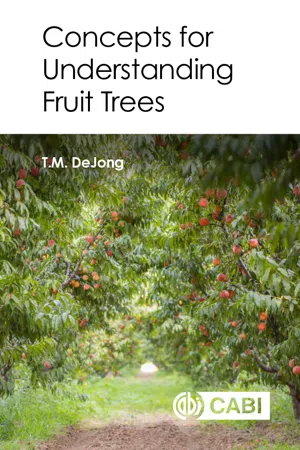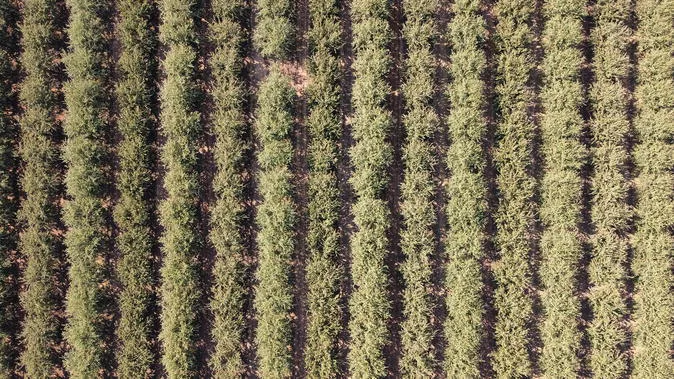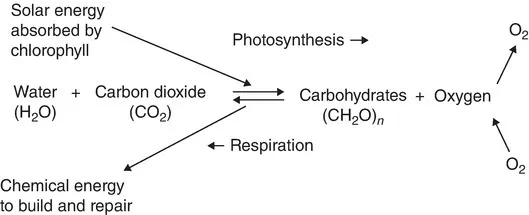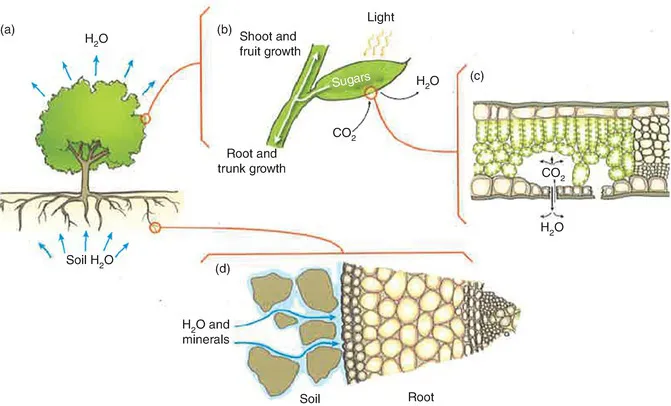![]()
In its essence, biology is the study of how living organisms cope with the constraints placed on them by the physical and chemical laws of the physical world in which they must survive and thrive. Thus, biology is essentially the discovery of biological solutions to solving problems posed by the physical world and other living organisms with which they coexist. This book focuses on concepts for understanding how a select group of biological organisms (fruit trees) are adapted to cope with the major constraints imposed on them by the physical world. In this context I choose to think of trees as problem solvers. Fruit trees are faced with multiple problems posed by physical limitations of their environment, such as variations in temperature, water, light and nutrient availability, and I try to identify some strategies that plants (especially fruit trees) have for solving those limitations in this book. However, in studying and thinking about plants and the problems they must solve, it is important to keep in mind that biology can’t change the laws of physics and chemistry, it can only develop strategies to deal with them.
Although scientists often emphasize the complexity of biological systems—and they are indeed complex when considering details of their genetics, biochemistry, molecular and cellular biology, physiology and ecology—the thesis of this book is that there are a few unifying concepts that make much of the general behavior and responses of fruit trees to the environment or management fairly easy to understand and predict. Presenting those unifying concepts is the primary goal of this book. Thus, this book is not meant to provide exhaustive details about any individual species of fruit trees or detailed descriptions of the genetics, biochemistry, molecular and cellular biology, physiology or ecology of fruit trees. This type of information is found in numerous pomology textbooks. A recent textbook that I would recommend for those details is Principles of Modern Fruit Science (Sansavini et al., 2019).
Most people who observe fruit trees and wonder how or why they behave in specific ways—such as growing very upright or more spreading, producing many flowers and small immature fruit only to drop most of the fruit later on, growing more on their sunny side than their shady side, etc.—ascribe such behavior to the trees as a whole. That is the wrong approach to understanding tree functioning and behavior. Trees are not in control of what they do. The control of what trees do and how they function lies in the individual organs that make up the tree, not in the tree as a whole. The genetic code of a tree only indirectly determines the habit, structure and behavior of a tree by defining the behavioral and functional limits of the organs, tissues and cells that make up the tree. Unlike animals, which have a mechanism for collective control of the whole organism (a nervous system), trees (and plants in general) can be more appropriately considered as collections of semi-autonomous organs that are dependent on one another for resources (water, energy (carbohydrates) and nutrients) but control their own destiny.
An excellent illustration of this principle is what has been described as a “five-in-one” fruit tree that is marketed to home gardeners. Such trees are attractive to home gardeners because they allow the production of different fruits (such as an early-ripening peach, a late-ripening peach, a nectarine, a plum and an apricot) all on a single tree. Such trees are produced by bud-grafting each of these fruit types on to a single rootstock. When this “five-in-one” tree grows, each branch representing the individual fruit types maintains the characteristics of those fruit types as if they were growing as individual trees. The structures produced by their growth (shoots, flowers, fruit, leaves, bark, etc.) and the timing of their development (bloom, leaf-out, pattern of shoot and fruit growth, time of fruit maturity, etc.) remain consistent with behaviors of the same varieties as individual trees. Therefore, the control of a “tree” cannot reside in the tree as a whole but trees must be viewed as collections of semi-autonomous organs that are collectively dependent on each other for resources to sustain their life. This brief book will explain how this view of fruit trees can lead to an integrated understanding of how fruit trees work.
Pomology (the science of growing fruit) has usually been approached by describing different types of fruit trees, their patterns of behavior and how they can be managed to efficiently produce. Tree physiology has generally been approached by describing the structural aspects and behavior of parts of trees and especially the perennial aspects of tree physiology, in addition to details about photosynthesis; respiration; nutrient uptake; biochemistry; water, nutrient and carbohydrate transport; etc., and then attributing the coordination of these processes and the behavior of the parts of the tree to the activities of plant hormones. However, there is rarely an attempt to address the fact that plant hormones are merely signaling molecules and there is little explanation for what or how the signals are initiated or controlled. Thus, there has been relatively little emphasis on trying to develop a set of unifying concepts for understanding what controls how fruit trees work.
I believe there is a general set of integrative concepts for understanding the overall physiology of temperate deciduous fruit trees. The emphasis here is on overarching principles rather than detailed descriptions of tree physiology or differences among the numerous species of fruit trees. Most of what is presented pertains mainly to temperate deciduous fruit trees but some aspects may also pertain to evergreen fruit trees or even trees that grow naturally in unmanaged situations.
Fruit trees are biological systems that have been engineered by nature and managed by humans to harvest solar energy to grow and produce fruit. Although most of our fruit trees have been genetically bred and selected by humans for specific characteristics that make them horticulturally valuable, it is important to remember that most of their physiological traits have been selected by nature to enhance their survival and reproduction in natural settings. In the process of developing strategies for dealing with the limitations of their physical world to survive and thrive on land, there are many issues to confront or problems to solve. It is instructive to continually analyze fruit trees from the viewpoint of understanding the problems they face for surviving and thriving on land, the adaptations they have for dealing with those problems and how they can be optimally managed for desired results.
In general, green plants are nature’s original biologically based solar-powered organisms. After the Industrial Revolution and until relatively recent advancements in modern sustainable energy development, much of the energy used to sustain life on earth has been derived from plant-based solar energy collection. The solar energy cells in green land plants are primarily housed in specialized structures (chloroplasts) within leaf cells and leaves are specially constructed to provide a controlled aqueous environment suitable for the function of those solar cells. Furthermore, the primary purpose of plant architectural structure (trunk, branches, stems and shoots) is to bear and display leaves so that they are exposed to solar energy (the sun’s rays). Thus, the productivity of any crop is a function of two things: the efficiency of resource (solar energy, water and nutrients) capture and assimilation; and the efficiency of distribution and use of those assimilated resources. Interestingly, while much research has been focused on understanding and enhancing the efficiency of resource capture and assimilation by plants, most agricultural advances have been based on manipulating resource distribution and use. This probably reflects the fact that it is hard to imagine a scenario in nature or in managed agriculture where anything but optimal resource capture and assimilation would be advantageous and selected for. Whereas there are many situations in managed agriculture where optimal distribution and use of resources in an anthropocentric monoculture may differ from what might be advantageous, and naturally selected for, in a competitive natural environment (e.g. plant stature, specific fruit characteristics, time of harvest, etc.). For this reason this book will only provide a cursory description of factors affecting the efficiency of resource capture and assimilation and the bulk of the focus will be placed on understanding how assimilated resources are distributed in fruit trees and how trees can be managed to optimize distribution of resources for horticultural gain.
Understanding the scheme of assimilate distribution within fruit trees allows for a more complete understanding of how fruit trees function and how horticultural manipulation of fruit trees can influence the growth of various organs, as well as how specific organ growth can be optimized to meet specific objectives.
![]()
Energy Capture and Carbon Assimilation | 2 |
Fruit and nut trees are not much different from other plants in that they are primarily adapted to obtain resources from their environment and use those resources to grow and produce propagules that can continue their survival as a species. The primary resources that plants are adapted to capture are (in order of importance) light energy, water and nutrients. Without energy a plant could do nothing. At its core, the primary purpose of the structure (branches) of a plant is to display solar energy collectors (leaves) and the primary purpose of leaves is to house and provide an efficient environment for the functioning of solar energy cells (chloroplasts within the green cells of leaves) (Fig. 2.1). Thus, optimal fruit trees and orchards are arranged and shaped for efficient capture of solar energy (Fig. 2.2). Water availability is essential to a plant and is primarily used to keep leaves in a hydrated state so that their solar energy cells (chloroplasts) can function efficiently. The solar energy that chloroplasts capture in their green pigments (chlorophyll) is stored in carbohydrates that are formed through the process of photosynthesis. The raw materials for this biochemical reaction are CO2 (carbon dioxide) and H2O (water) and the products are CH2Os (sugars or carbohydrates) and O2 (oxygen) (Fig. 2.3). CO2 is obtained from the atmosphere and H2O is obtained from water stored in the soil. However, the fact that CO2 needs to be absorbed from relatively dry air surrounding the plant, and that chloroplasts need to be maintained in a hydrated state, poses a major problem for the plant. Leaves are structures designed to specifically solve this problem. They have specialized pores (stomata) that help control the amount of water that is lost from the fully hydrated leaf while CO2 is being taken up from the relatively dry air surrounding the plant. The primary use of water in land plants is to replace the water that is lost from leaves while they are taking in CO2 to supply photosynthetic reactions.
Fig. 2.1. Cross-section of the internal structure of a leaf. The chloroplasts (solar energy cells) are located in the palisade and mesophyll cells. The arrows through the stomatal pores indicate the pathways and resistances for water vapor and CO2 movement out of and into the stomatal pores of the leaf. (From Taiz et al., 2015.)
Fig. 2.2. An aerial photo of a California almond orchard. Trees are planted and pruned to optimally distribute and capture sunlight within their canopies. Thus, these systems represent biological solar arrays. (Photo by E. DeJong.)
Fig. 2.3. Diagrammatic summary of the fundamental biochemical reactions of photosynthesis and its inverse, respiration. (From DeJong, 1989.)
Since water loss by leaves through evaporation from leaf surfaces (transpiration) during the process of photosynthesis is the major use of water by land plants, this is also the main driving force for movement of water from the soil water pore spaces, into and through the roots, up the stem, out to the leaves and into the atmosphere. This pathway of water movement through plants is termed the soil–plant–atmosphere continuum (SPAC) (Fig. 2.4). Scientists measure the driving force for movement of water through this continuum in terms of water potential (Ψ). Pure water has a water potential equal to 0.00 MPa and water always moves from a less negative to a more negative water potential. The water potential (Ψw) of a plant cell is the sum of two components: Ψs and Ψp (Ψw = Ψs + Ψp). Ψs is the solute potential and it is an expression of the tendency of the solute to attract water (like the tendency for salt in a saltshaker to absorb water). Ψp is the pressure potential (turgor pressure in plant cells) and it is the pressure that is exerted on the wall surrounding a cell due to the fact the cell contains a lot of solutes that attract water. Ψs is always negative because it is an expression of the tendency of solutes to attract water and Ψp is always positive in living plant cells and is an expression of the tendency for cells to expand.
Fig. 2.4. Diagram of the soil–plant–atmosphere continuum (SPAC) of water flow through trees. Water is taken up from the soil by roots (d) and moves through the tree (a) and leaves (b) and out of the leaves through stomata (c) to the atmosphere. (From DeJong et al., 2012.)
When considering movement of water among cells in a plant or between the plant and its surroundings, the difference in water potential between any two points along the continuum indicates the relative tendency and direction of movement of water between those points. For instance, the water potential of open air in an orchard ranges from –10 to –100 MPa, while the water potential of leaves of adequately irrigated orchard trees can range from –0.2 to –1.5 MPa. Thus, there is almost always a tendency for water to move from the leaf to the atmosphere. Similarly, soil water potential in an irrigated orchard is generally less negative than –0.2 MPa; thus there is almost always a tendency for water to move from the soil through the roots and stem to the leaves. The actual rate of movement through the entire system is dependent on the differences in water potential and resistances to water movement between various points along the SPAC pathway. It is important for growers to manage irrigation so that tree leaves never (or rarely) experience mid-day leaf water potentials more negative than a recommended baseline value during the growing season.
Similar to water use, the majority of many nutrients that are taken up from the soil are used to build and maintain the photosynthetic apparatus in the leaves and to facilitate energy exchange in other pl...




